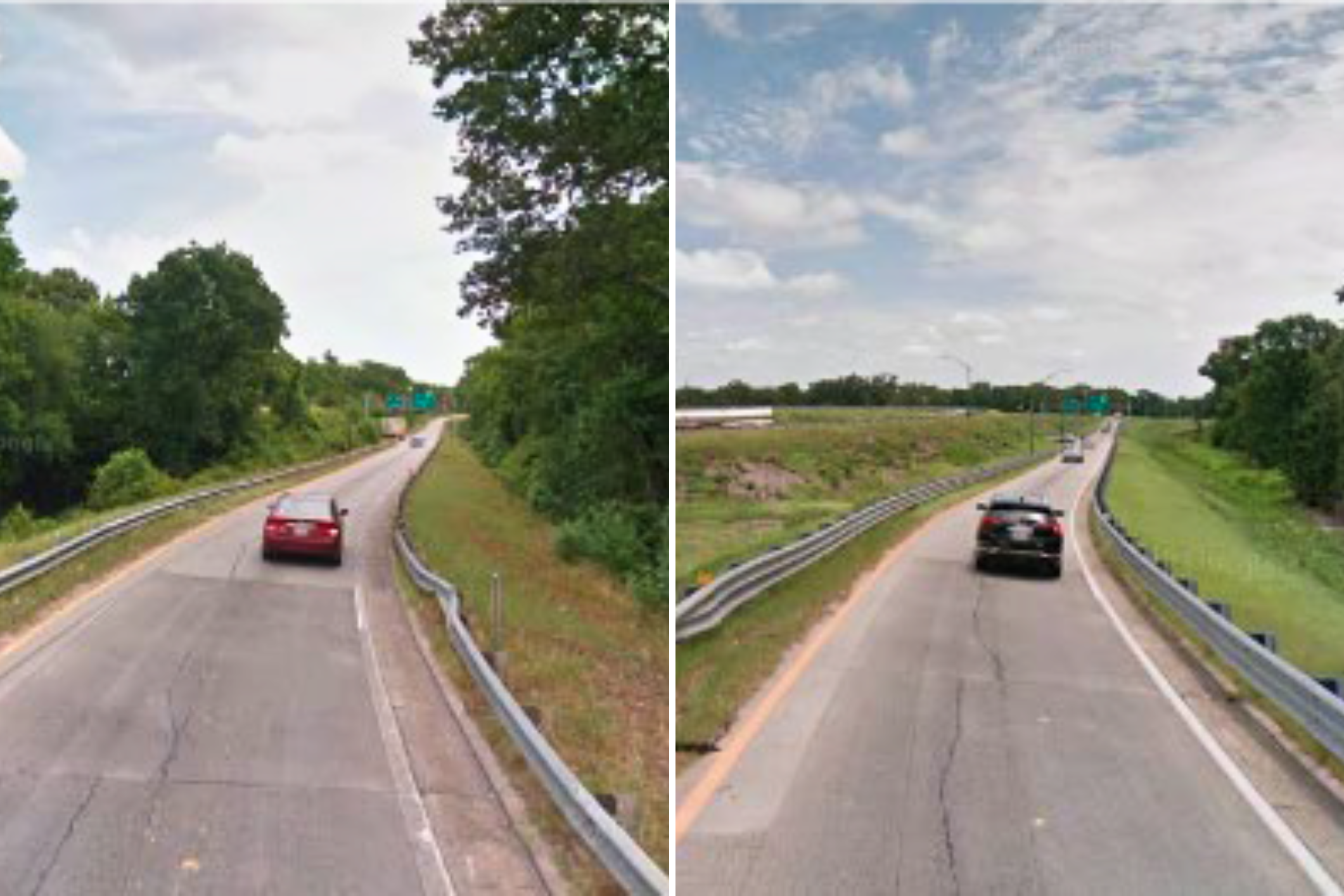Pictured above: Before and After Street View Images, May 2014 and July 2019, Interchange of I-16 and I-516 in Georgia
By Ellen Oettinger White and Robert B. Noland
Many state highway agencies approach transportation safety from the perspective of maintaining fast and free-flowing traffic. As such, highway design guidelines specify a “clear zone” along highways; that is a zone free of fixed objects that vehicles may crash into. Trees are classified as a fixed object and are indiscriminately removed along many corridors to provide a standard 30-foot clear zone. Some agencies even clear trees far beyond 30 feet—even up to hundreds of feet from the road edge (see image above). This is done despite limited evidence on the effectiveness of tree removal to reduce traffic fatalities.
Many “run-off-the-road” crashes have causes unrelated to trees. These crashes are more common among young men and those who have been drinking, and they tend to occur at night. Speeding is also a major factor. Granted, once a vehicle leaves the highway, a tree may be the only thing that stops its forward motion, so there is some risk involved. However, in the last 30 years or so, protection of vehicle occupants when there is a crash has been substantially improved due to vehicle regulations and the installation of airbags. The guidelines that specified a 30-foot clear zone are more than 50 years old and promulgated at a time when occupant protection was almost non-existent and cars were “unsafe at any speed” (Nader, 1965).
Recent research (White, 2023) examined how trees are perceived by staff in state transportation agencies. White interviewed 36 staff involved with roadside design and tree management at agencies to understand how well the decision process works.
One finding was that some staff view trees solely as “safety hazards” while others understand the environmental benefits they can provide. These benefits include carbon sequestration, protection of ecosystems and wetlands, stormwater management, and erosion control, as well as providing an aesthetic environment. There is also evidence that roadside trees can lead to slower speeds, which can reduce the frequency and severity of crashes.
White’s research found that a lack of collaboration often occurs within state transportation agencies. Engineering staff usually have more control over decisions on tree clearance, and maintenance staff cite the design guidelines that recommend a 30-foot zone. But the 30-foot dimension isn’t always appropriate, as the guidelines emphasize that one size does not fit all (AASHTO, 2011). Even the original studies on which these guidelines are based acknowledge limitations in the data and state that trees can benefit traffic safety (Cooper, 1981; Hutchinson and Kennedy, 1966). White found that environmental and landscape staff within agencies are unable to challenge decisions made by engineering staff, who sometimes operate without consulting their peers in environmental or landscape design roles. In addition, no environmental review is required for an agency to conduct massive amounts of tree clearance in the name of “safety” if the clearing is classified as maintenance.
Some conclusions from the staff interviews were that collaboration between disciplines is challenging. Those with different disciplinary backgrounds often have different levels of influence on decision making. Most staff recognized that collaboration could lead to better environmental outcomes as well as reduced public outcry over indiscriminate tree removals. Much of the effort to collaborate comes from non-engineering staff, while engineering staff often have “checked that box off” after a couple meetings.
The conclusions for future policy are to provide more incentives for collaboration and decision-making that examines the balance between any safety improvements and environmental benefits. There is also a recognition that the dated guidelines on the clear zone need to be reconsidered.
References:
AASHTO, 2011 Roadside Design Guide. 4th Edition. AASHTO, Washington, D.C.
Cooper, P. J. (1981). Analysis of Roadside Encroachment Data from Five Provinces and Its Application to an Off-Road Vehicle Trajectory Model. British Columbia Research Council, Vancouver, Canada.
Hutchinson, J. W. and Kennedy, T.W. (1966). Medians of Divided Highways: Frequency and Nature of Vehicle Encroachments. Engineering Experiment Station Bulletin 487. University of Illinois, Champaign.
Nader, R. Unsafe at Any Speed: the Designed-in dangers of the American automobile. Grossman Publishers, 1965.
White, E. O. (2023). Roadside Tree Removal: Causes, Consequences, and Who Decides [Doctoral dissertation, Rutgers, The State University of New Jersey]. https://doi.org/doi:10.7282/t3-17w2-8107
White, E.O. “Unclear territory: clear zones, roadside trees, and collaboration in state highway agencies.” Transportation research part D: transport and environment 118 (2023): 103650. https://doi.org/10.1016/j.trd.2023.103650

